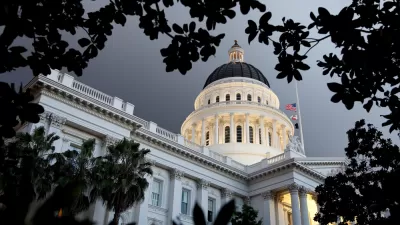Driving accounts for 62 percent of all trips in San Francisco - the same level as when the city's pioneering transit-first policy was adopted 40 years ago. Aaron Bialick looks at the reasons why the policy has led to "scant visible progress."
"When the San Francisco Board of Supervisors adopted a transit-first policy on March 19, 1973 — 40 years ago this week — a return to the early 1900s streetscape may not have been what they had in mind, but the city’s intent to undo decades of urban planning and governance geared towards promoting driving at the expense of public transit was clear," notes Bialick. "A key provision of the policy reads, 'Decisions regarding the use of limited public street and sidewalk space shall encourage the use of public rights of way by pedestrians, bicyclists, and public transit, and shall strive to reduce traffic and improve public health and safety.' (The policy was amended to include pedestrians and bicyclists in 1999.)"
"Yet today, the vast majority of San Francisco’s street space remains devoted to moving and storing private automobiles, making the public right-of-way hostile to walking and bicycling," he adds. "Muni remains underfunded, with vehicle breakdowns and delays caused by car traffic a daily part of riding transit."
While the SFMTA, elected officials, and city residents are all blamed for the lack of progress, some like Supervisor Scott Wiener are working to put muscle behind a policy that many feel was ahead of its time.
"If San Francisco were to be graded on its implementation of transit-first, 'I would give us a C+,' said Wiener. 'In a lot of areas, the MTA is moving in the right direction, but it needs to move faster and more aggressively.'"
FULL STORY: At 40 Years, San Francisco’s Transit-First Policy Still Struggles for Traction

Alabama: Trump Terminates Settlements for Black Communities Harmed By Raw Sewage
Trump deemed the landmark civil rights agreement “illegal DEI and environmental justice policy.”

Study: Maui’s Plan to Convert Vacation Rentals to Long-Term Housing Could Cause Nearly $1 Billion Economic Loss
The plan would reduce visitor accommodation by 25% resulting in 1,900 jobs lost.

Planetizen Federal Action Tracker
A weekly monitor of how Trump’s orders and actions are impacting planners and planning in America.

Wind Energy on the Rise Despite Federal Policy Reversal
The Trump administration is revoking federal support for renewable energy, but demand for new projects continues unabated.

Passengers Flock to Caltrain After Electrification
The new electric trains are running faster and more reliably, leading to strong ridership growth on the Bay Area rail system.

Texas Churches Rally Behind ‘Yes in God’s Back Yard’ Legislation
Religious leaders want the state to reduce zoning regulations to streamline leasing church-owned land to housing developers.
Urban Design for Planners 1: Software Tools
This six-course series explores essential urban design concepts using open source software and equips planners with the tools they need to participate fully in the urban design process.
Planning for Universal Design
Learn the tools for implementing Universal Design in planning regulations.
Caltrans
Smith Gee Studio
Institute for Housing and Urban Development Studies (IHS)
City of Grandview
Harvard GSD Executive Education
Toledo-Lucas County Plan Commissions
Salt Lake City
NYU Wagner Graduate School of Public Service





























